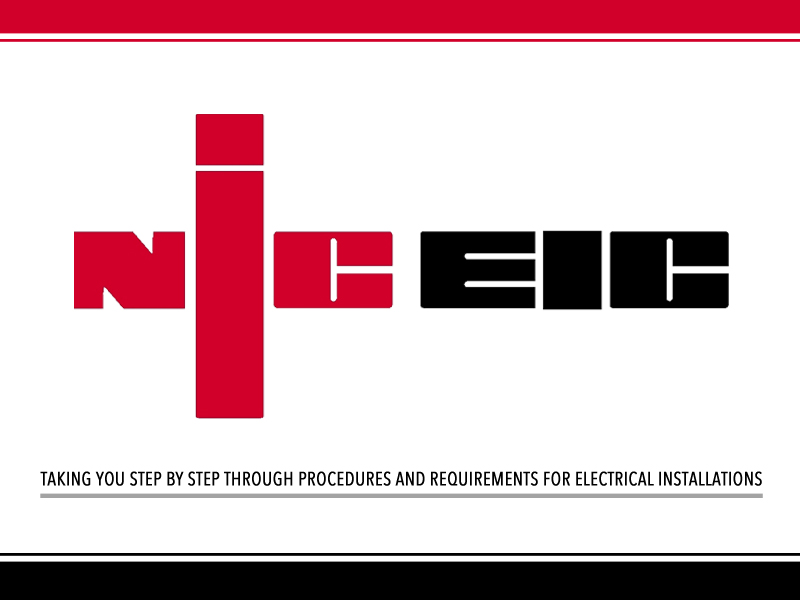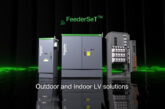
The technical team at NICEIC & ELECSA provide guidance and advice when choosing the correct type of blanking plates to use on domestic consumer units.
The aim of this article is to assist the contractor when selecting appropriate types of blanking plates to be used in domestic consumer units, so that Regulation Group 416.2 – Barriers or enclosures is met. It also provides guidance on the recording details to be used where a non-compliance with Regulation 416.2.1 is identified during a visual inspection as part of a periodic report.
Introduction
Consumer units that comply with BS EN 61439-3: 2012 Low-voltage switchgear and controlgear assemblies are intended to be operated by ordinary persons. As such, are not typically fitted with any type of locking mechanism for the front lid as shown in Fig 1. To gain access to the fuses or circuit-breakers, the lid is easily lifted without requiring the use of a tool or key.
FIG 1 (ABOVE): TYPICAL METAL-CLAD CONSUMER UNIT USED IN DOMESTIC PREMISES
Protection against electric shock
Typically, a new consumer unit is provided with a full complement of circuit-breakers, any that are unused are normally marked as spare ways to accommodate any future work.
Where extra circuit-breakers are not fitted, leaving gaps in the opening, and live parts contained within are accessible and uninsulated, a blanking plate as shown in Fig 1 must be fitted. However, where the internal bus-bar(s) are insulated and there are no exposed hazardous live parts accessible to the touch, a blanking plate is not strictly necessary. The insulation on the bus-bar provides the provision for basic protection under normal conditions and as such acts as a barrier (416.1).
Regulation 416.2.1 states that where the lid of a consumer unit or other such enclosure can be opened without the use of a tool or key, there shall be a secure barrier preventing persons coming unintentionally into contact with live conductive parts. The degree of protection for the insulating barrier shall be to IPXXB or IP2X, and shall be sufficiently secured as to need a tool or key for removal.
Manufacturers of consumer units produce a range of different styles of blanking plates which can be of metal or plastic construction.
There is no regulatory requirement for the blanking plates to be of metal construction, since they are intended to be mounted inside a consumer unit, with a closed lid, which should comply with Regulation 421.1.201.
The illustrations in Fig 2 show some of the more common types of blanking plates in use today.
Blanking methods of the type shown by a) and b) cannot be removed without first removing the cover plate of the consumer unit. This would require the use of a tool, invariably a screwdriver. The blanks shown should satisfy the requirements of Regulations 412.2.2.3 and 416.2.1 and provide unskilled persons with adequate protection against the risk of electric shock, when lifting the lid to re-set circuit-breakers or replace fuses.
However, whilst the clip-in blanking plate of Fig 2c) does not require the use of a tool to place it into position, it does require a certain degree of force to ensure both top and bottom clips are securely located, and an almost equal amount of force is required to remove the clip. Where the clips of the barrier plate shown in Fig 2c) are worn, damaged or loose and no longer provide a secure fit, they should be replaced with those supplied by the manufacturer of the consumer unit to maintain the required degree of protection against unintentional contact with hazardous live parts. The use of insulation tape to secure loose blanking plates or for the sealing of gaps within the front cover is not considered acceptable in providing suitable protection from contact with live parts.
FIG 2 (ABOVE): TYPICAL EXAMPLE OF BLANKING PLATES IN COMMON USAGE. *1- dummy circuit breaker clips onto the DIN rail of the consumer unit; *2- this metal barrier is fixed onto the front cover by twisting into postition; *3- this barrier clips into the consumer unit cover plate.
International Protection (IP) code
Regulation 416.2.1 requires the insulating barrier to have a degree of protection to IPXXB or IP2X.
IP2X – this defines the degree of protection required to prevent access to hazardous live parts with fingers and to protect the equipment inside the enclosure against the ingress of solid foreign objects. Protection against the ingress of water is not required.
Full details of the testing criteria can be found in BS EN 60529: 1992+A2: 2013 Degrees of protection provided by enclosures (IP code). Basically, to verify there can be no contact with hazardous parts, there should be clearance when a test finger of 12 mm diameter has penetrated 80 mm deep into the enclosure. A second check is made to verify that it should not be possible for solid foreign objects, spherical in shape and larger than 12.5 mm in diameter cannot fully penetrate the enclosure at any point.
IPXXB – This means protection against ingress of solid foreign objects and water is not required and access to hazardous live parts is protected for incidental contact with fingers. The test for compliance is made with the standard test finger as for IP2X.
Periodic inspection
Where a non-compliance with Regulation 416.2.1 is detected during a periodic inspection, and it is the considered judgement of the inspector that the use of simple blanking plates is inadequate, the inspector must clearly state the Regulation pertaining to the non-conformance. The inspector should describe the risk presented to the user of the installation within the Observations and Recommendations for actions to be taken of the Report (for example Part 6 of DPN18).
On the Schedule of Items Inspected, a suitable code would be entered under the heading:
4: Consumer unit(s) / Distribution board(s); 4.3 Condition of enclosure(s) in terms of IP rating.
The actual code entered would be based upon the risk presented to the users of the installation. Where it is found that there are lids and/or blanks missing and direct contact with live parts is possible, the risk of direct contact may require a Classification code C1 and possibly, issue of a danger notice. Such a potential risk of electrical shock would need to be rectified and made safe upon discovery. However, where a blank is missing or appears inadequate, but it is not possible for persons to come into contact with live parts, then no code need be issued.
A comment will need to be provided to clarify the Classification code given. Such a comment with details may be something similar to that shown in Fig 3.
FIG 3 (ABOVE): COMMENT GIVEN FOR A NON-COMPLIANCE DETECTED.
Summary
The fitting of appropriate blanking plates in consumer units is usually necessary in order to comply with Regulation 416.2.1. Preferably, the blanking plates should be of the type requiring a tool or key to remove them. However, this doesn’t preclude the use of clip-in types often provided with new consumer units, providing they have been fitted in accordance with manufacturers’ instructions and provide a secure barrier to the live parts inside the enclosure.
The blanking plates need not necessarily be manufactured out of steel; they can be of plastic construction. It must be borne in mind that protection against fire propagation is provided by the non-combustible enclosure of the consumer unit in accordance with Regulation 421.1.201.
Where non-compliance is detected during a visual inspection as part of an Electrical Installation Condition Report, an appropriate Classification code pertaining to the level of risk is entered and details provided for actions to be taken.
Get more details about NICEIC registration by clicking here











